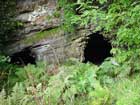| Limestone
 Limestone
is primarily a biogenic sedimentary rock, although under certain environmental
conditions abiogenic precipitation of calcium carbonate is thought to
occur. The majority of limestone is composed of the broken fragments of
skeletal material from animals and calcareous plants. The particles may
be as fine as mud (chalk) or may consist almost entirely of pebble sized
skeletal plates that may reside within a fine matrix or be cemented by
sparry calcite (crinoidal limestone). Limestone
is primarily a biogenic sedimentary rock, although under certain environmental
conditions abiogenic precipitation of calcium carbonate is thought to
occur. The majority of limestone is composed of the broken fragments of
skeletal material from animals and calcareous plants. The particles may
be as fine as mud (chalk) or may consist almost entirely of pebble sized
skeletal plates that may reside within a fine matrix or be cemented by
sparry calcite (crinoidal limestone).
On
Arran, the majority of limestone that can be found belongs to the Carboniferous.
Repeated fluctuations in relative sea level allowed for the near rhythmic
deposition of limestone associated with shale, sandstone, seat earth and
coal. Known as Milankovitch cycles, these repeated units of sedimentary
rocks record the transgression and regression of the sea with respect
to land, and can tell a lot about the environment of deposition due to
their abundance of fossils.
 Above
the road at Corrie Harbor, The Corrie Limestone is exposed in a quarry.
The remains of a lime kiln also exist. The limestone was quarried for
liming the acidic soils of Arran to improve agriculture. The caves associated
with the working are dangerous and should not be entered. Fossils of Gigantoproductus
brachiopods can be found in the Corrie Limestone. Above
the road at Corrie Harbor, The Corrie Limestone is exposed in a quarry.
The remains of a lime kiln also exist. The limestone was quarried for
liming the acidic soils of Arran to improve agriculture. The caves associated
with the working are dangerous and should not be entered. Fossils of Gigantoproductus
brachiopods can be found in the Corrie Limestone.
Follow this
link to find out more about the commercial
value of limestone, an important natural resource.
|

